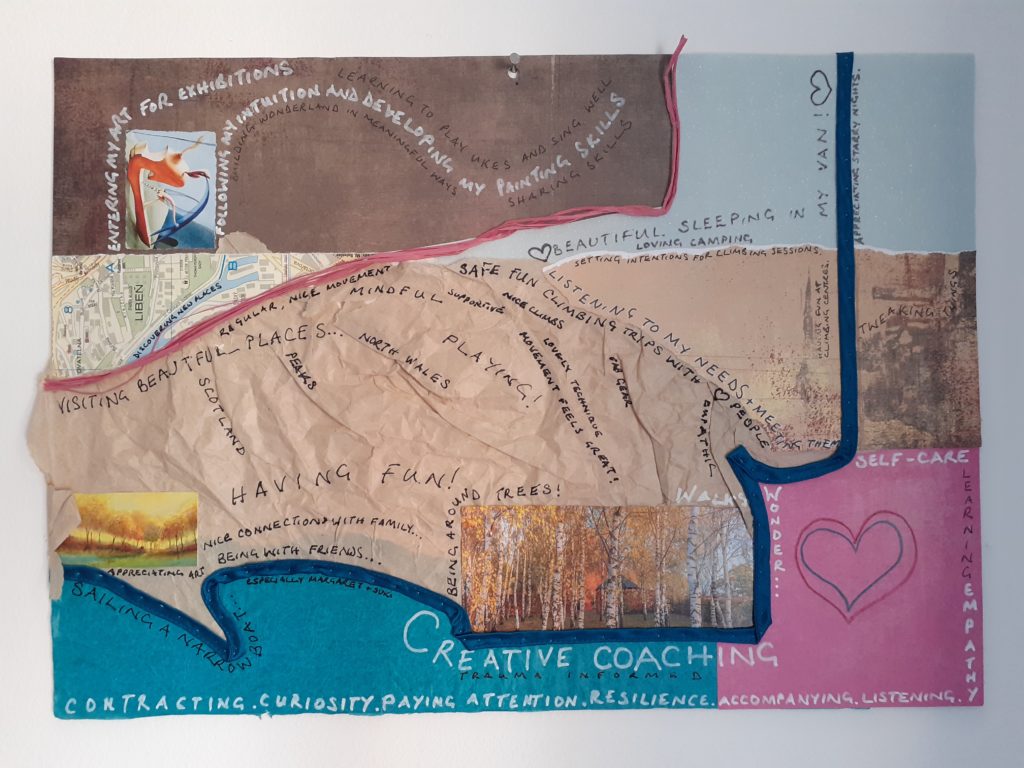
The traditional way of creating a vision board is to create one that contains images and affirmations for your future self. If, however, your Inner Critic is likely to beat you up for not doing the things on your vision board, or even tell you you’ll never do those things, it might be better to create a different kind of vision board. In this article, I’ll show you the one I made and I’ll share some different ways of using vision boards.
Here’s a Vision Board I Made Earlier
I knew I didn’t want to make a traditional vision board with images of things achieved plus affirmations. Sports people visualise themselves performing well, rather than taking home a trophy, and this tends to work – the trophy is the by-product of performing well. I wanted to bring this aspect into my vision board. Here’s how I created it:
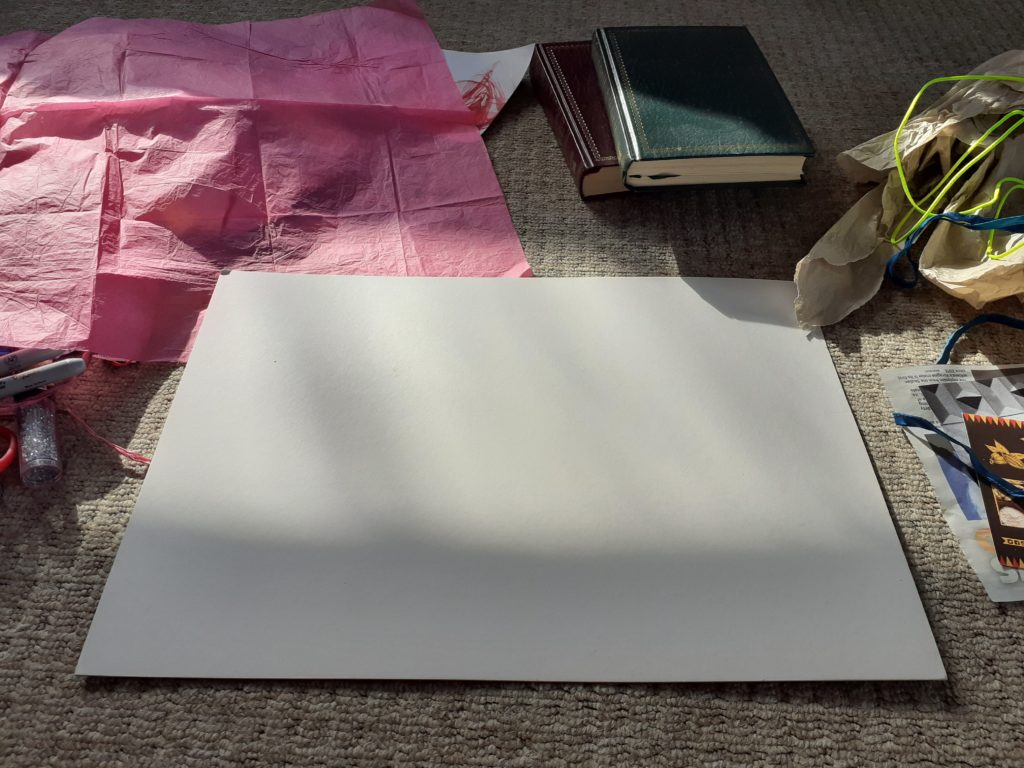
Gather Your Vision Board Materials
I used an A3 board, which I got in a pack of five from an art shop. What you use for your base is up to you – could be something you buy especially or something you have lying around. Over time, I’ve collected magazines, wrapping paper, wallpaper samples, string, ribbon and all sorts of things. I got these out of my collage bag and spread them around the lounge floor.

If you don’t have any collage materials, you can visit places like libraries, cafes, and DIY shops to get free magazines and wallpaper samples. You could ask the people you know to give you their old magazines and newspapers. You’ll also need glue and possibly a needle and thread to attach things to your base. You might like to get hold of some decorative stuff like ecologically friendly glitter or ribbon to create borders or emphasise areas of your vision board.
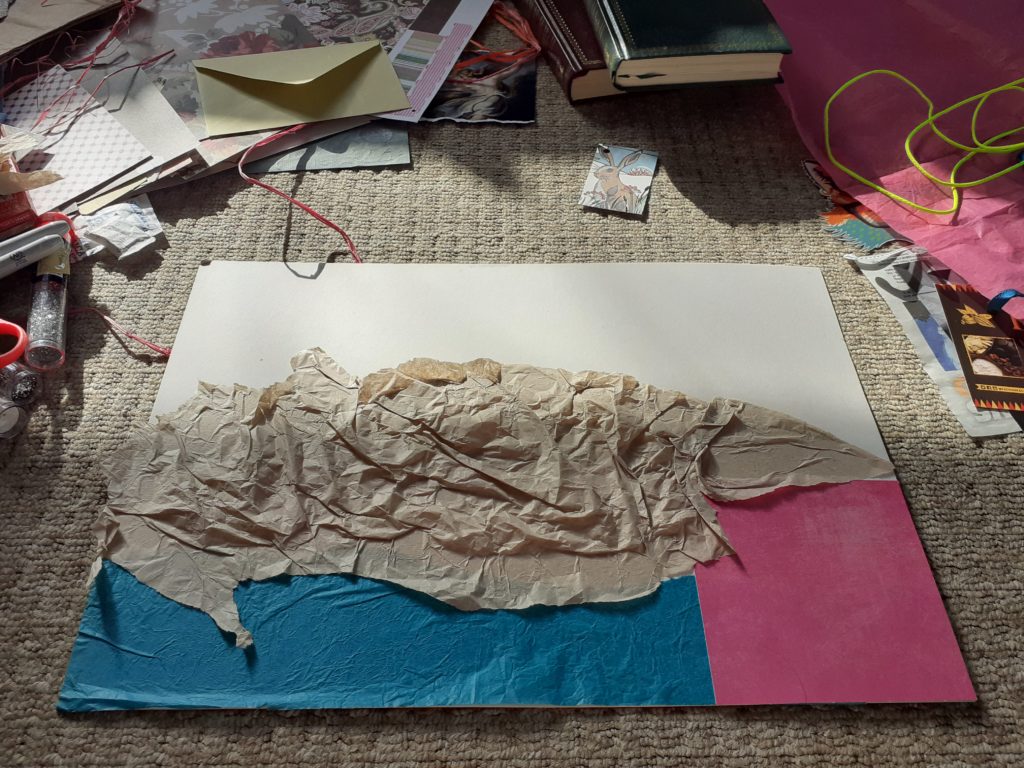
Ask Yourself A Question
I sat quietly and asked myself this question: “imagine it’s 31st December 2020 and you’re doing a year review of the things you loved about 2020. What are you including?” It took a little while for my mind to get into the task of projecting myself into the future so I cradled my mug of tea and waited. As ideas appeared in my mind, I wrote them down and ended up with a list.
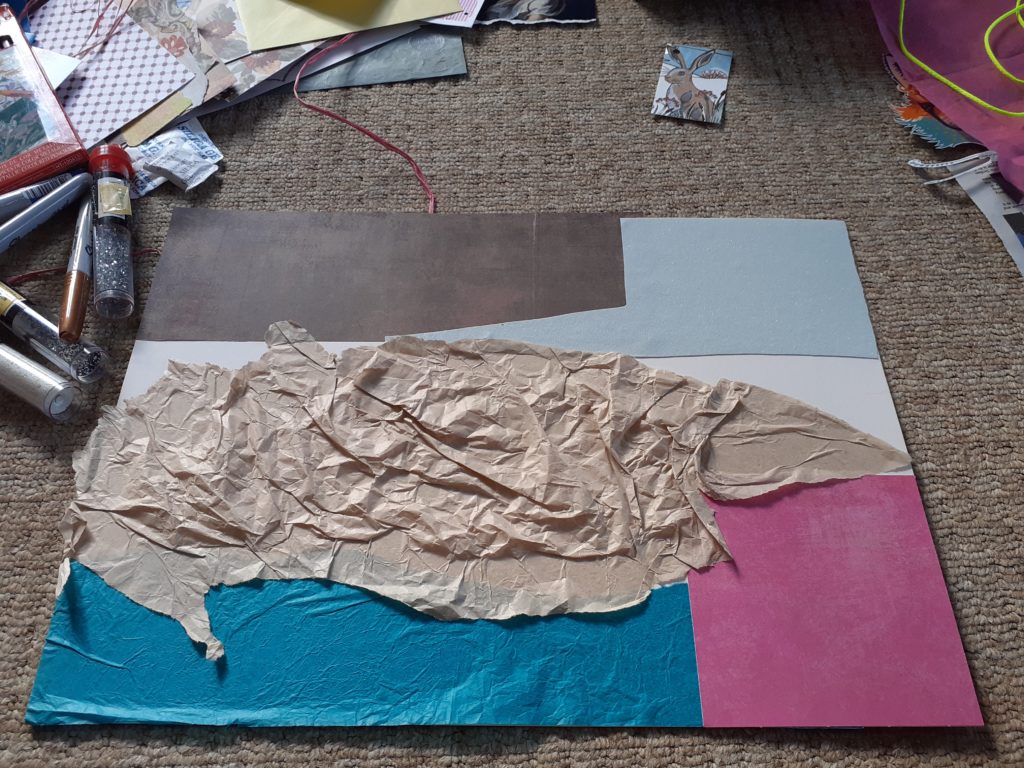
Choose Materials to Stick to Your Vision Board
I chose colours and textures I liked, using glue to stick them to the base. Some of the colours represent areas of my life: teal and pink for my coaching practice, brown for rock climbing. I didn’t know what some of the colours represented until later – I was just drawn to them and stuck them on. Then I sewed a ribbon on, which looks like a river on a map. It felt very satisfying to me to put these shapes and textures together. I’ve always enjoyed that aspect of collage. I also added a few images of trees and a piece of abstract art.
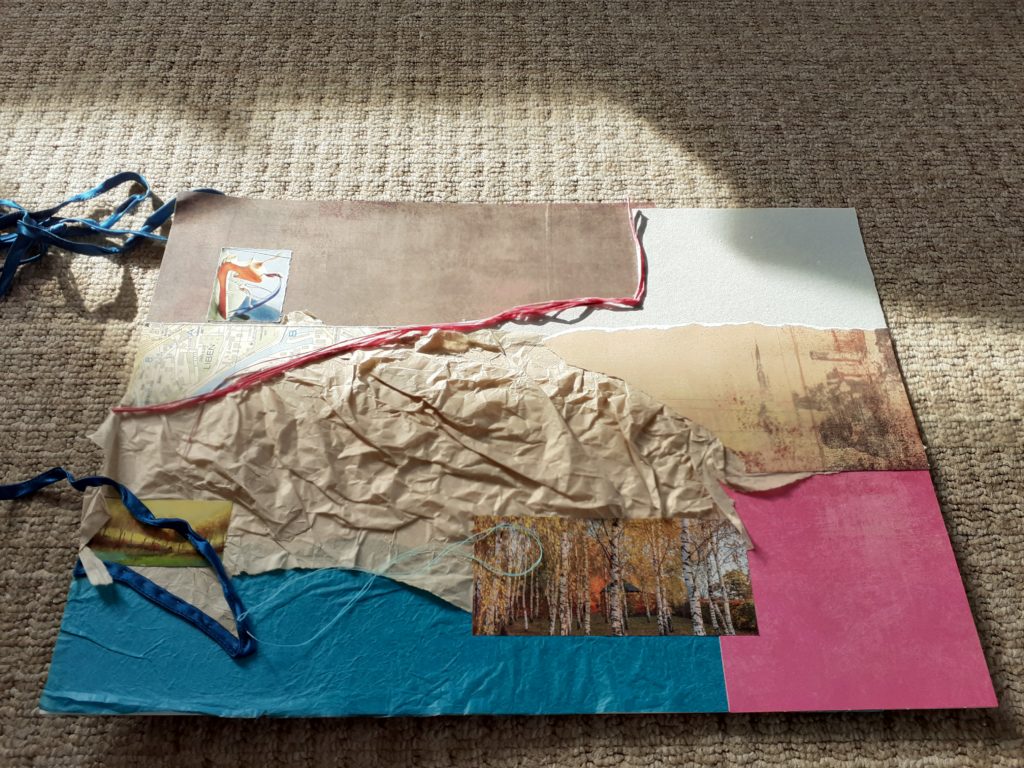
Add Words to Your Vision Board
Next I added words that represented me doing the things I’d love to do this year. The important part of this is that they were ‘doing’ words. I went back to my list of things I loved about 2020 and created phrases like, “paying attention” or “listening to my needs and meeting them”. I wrote these phrases on my vision board. I couldn’t stop grinning as I wrote and thought about the people, places and activities I love.
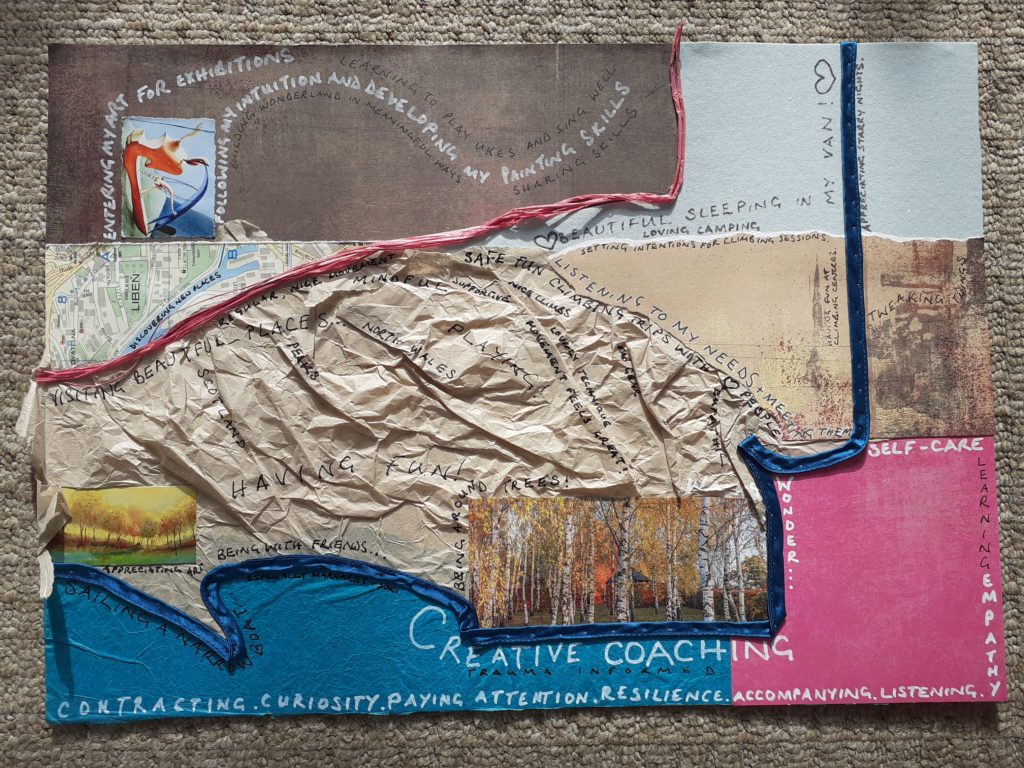
Find a Place For Your Vision Board
I hung my vision board on my bedroom wall opposite the foot of my bed, but I couldn’t see the details because it was too far away. I moved it to the wall at the side of my bed and now I can easily see it last thing at night and first thing in the morning. I feel like it’s not quite finished yet and I’ll probably add to it, but for now it’s nice to look at and I especially like the feeling I get when I read “beautiful sleeping in my van!” In fact, I’ve already started working on making that happen by ordering some thicker foam to make a comfy mattress out of (mine is too thin to be comfy).
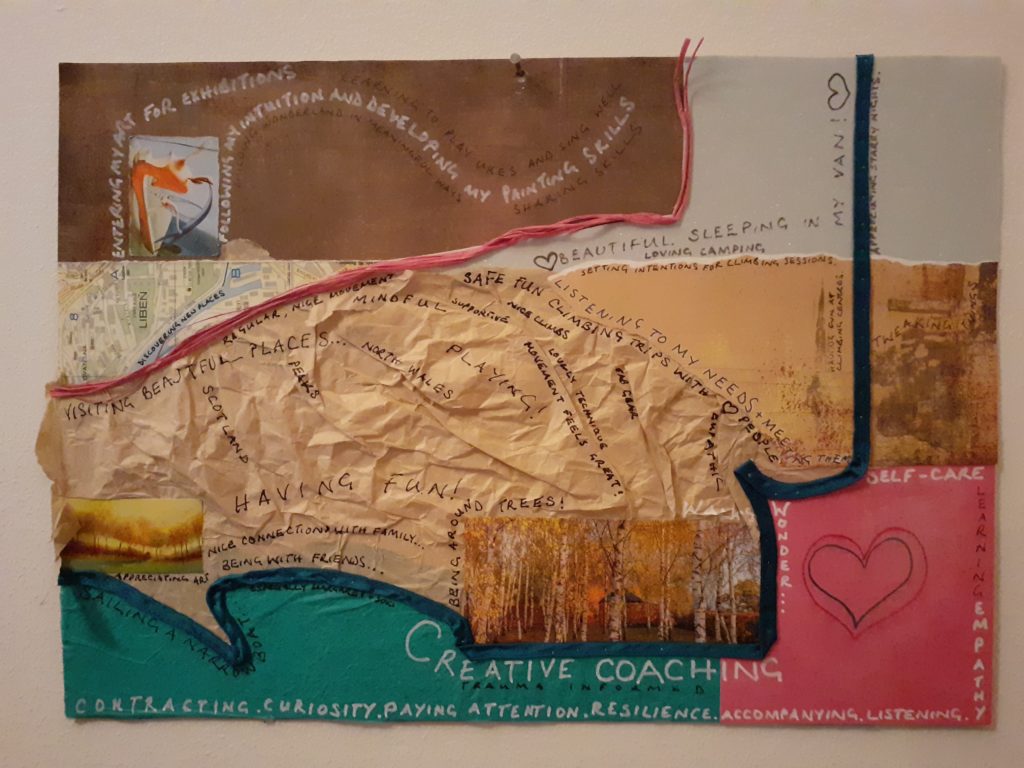
You don’t have to display your vision board where you’ll see it every day. In fact, if you feel self-critical a lot, it’s best not to. You could put it away and then make a date with yourself to get it out at the end of the year. Or you could make a ritual burning of it – by letting go in such a way, you’d certainly not be grasping after things and thereby pushing them away. There are no right or wrong ways of using a vision board – it’s up to you and what suits you best.
What I Made at My Vision Board Workshop

On 16th February I facilitated a vision board Wonder Workshop. I joined in with the participant – I do this to ease the pressure because being watched by a facilitator is not always helpful. We talked about different kinds of vision boards and decided which kind each of us would make. I made one that shows a very young part of myself that loved to play but was often violently reprimanded for playing. Alongside that young part is the compassionate part of myself that I have developed over time, and that part is keeping a watchful eye over the young part and telling her, “and that’s okay”. The compassionate part is strong, loving, caring, kind, sensual, soft-spoken, flowing (like the calm river attached to her), smiling, laughing, listening, nonjudgmental, and unerringly truthful.
Other Ways of Using Vision Boards
Whilst researching vision boards I came across a couple of other ways of using them that might be useful, particularly if you’ve experienced trauma at some point. One of these is to envision a safe space (Tolleson and Zeligman, 2019). Another is to capture things you feel inspired or soothed by like songs, films, stories, smells, tastes, and maybe even a person or people. Finally, Stacy Speedlin used a vision board technique to create a memoir of her mentor, who died suddenly. She stuck her mentor’s words to a board, along with a photograph of her, and when she deeply misses her, she looks at the board and ‘hears’ her words (Speedlin et al, 2015). What a beautiful way to remember somebody and their impact on you!
Conclusion
Yes, vision boards can help your mental health, if you fit them to your needs. So, the most important thing about vision boards is first defining your needs. Perhaps you need to envision yourself doing the things you’d like to do well. Or maybe you need to capture what you value, or what soothes you, or some comforting things to remember about someone you’ve lost. Vision boards are a great way of creatively capturing positive aspects. What might you use a vision board for?
References
SPEEDLIN, S., MILLIGAN, K., and VILLAREAL-BONILLA, N., 2015. Memoirs of a Mentor: Using Creativity for Counselors in Coping With the Loss of a Mentor. Journal of Creativity in Mental Health [online], 10 (2), pp. 247-257. Available from: https://doi-org.edgehill.idm.oclc.org/10.1080/15401383.2014.979963
TOLLESON, A., and ZELIGMAN, M., 2019. Creativity and Posttraumatic Growth in Those Impacted by a Chronic Illness/Disability. Journal of Creativity in Mental Health [online], 14 (4), pp. 499-509. Available from: https://doi-org.edgehill.idm.oclc.org/10.1080/15401383.2019.1632769
